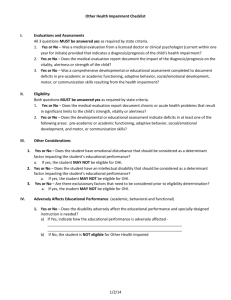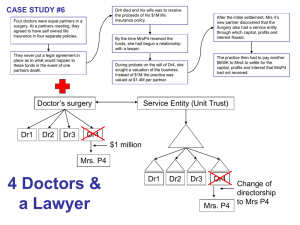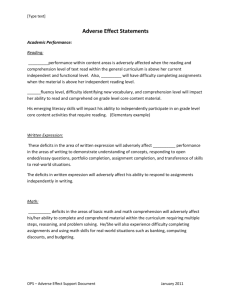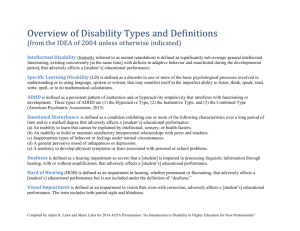project evaluation - CAL
advertisement
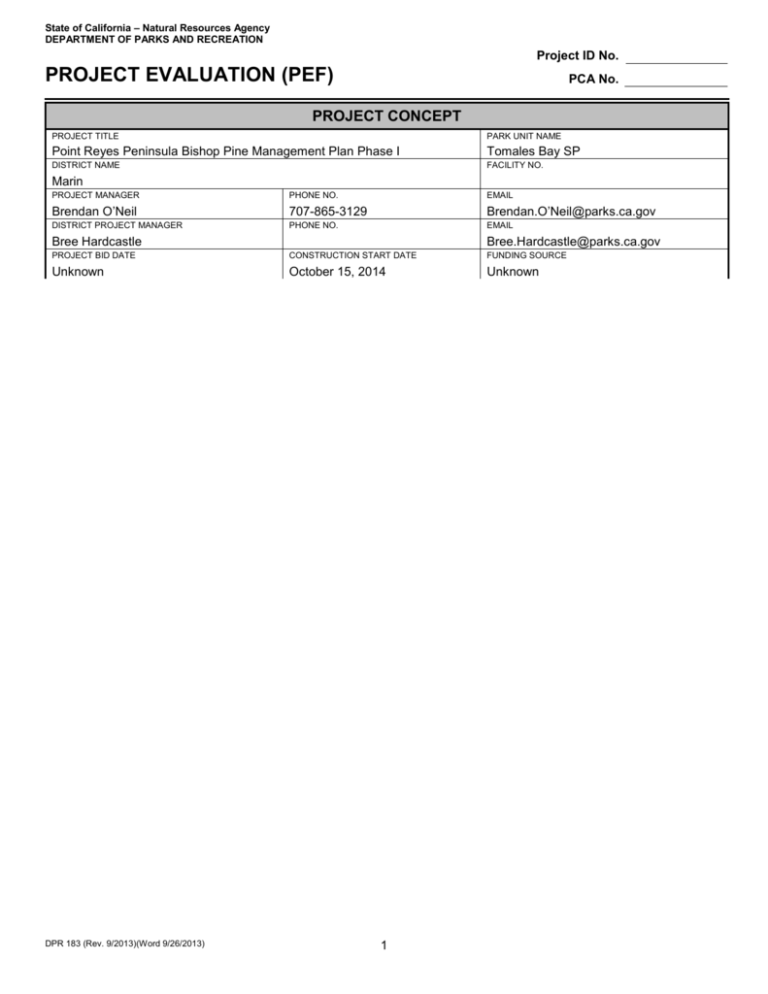
State of California – Natural Resources Agency DEPARTMENT OF PARKS AND RECREATION Project ID No. PROJECT EVALUATION (PEF) PCA No. PROJECT CONCEPT PROJECT TITLE PARK UNIT NAME Point Reyes Peninsula Bishop Pine Management Plan Phase I Tomales Bay SP DISTRICT NAME FACILITY NO. Marin PROJECT MANAGER PHONE NO. EMAIL Brendan O’Neil 707-865-3129 Brendan.O’Neil@parks.ca.gov DISTRICT PROJECT MANAGER PHONE NO. EMAIL Bree Hardcastle Bree.Hardcastle@parks.ca.gov PROJECT BID DATE CONSTRUCTION START DATE FUNDING SOURCE Unknown October 15, 2014 Unknown DPR 183 (Rev. 9/2013)(Word 9/26/2013) 1 Project ID No. PROJECT EVALUATION (PEF) PCA No. PROJECT DESCRIPTION Identify the scope of the project in detail, including its purpose, location, and potential impacts. If the ground is to be disturbed, describe the depth and extent of excavation. Describe the existing site conditions, including previous development. Note if work will impact or extend beyond park property. Indicate if work will be done in conjunction with, or as part of, other projects. (Use additional pages if necessary.) Within Tomales Bay State Park the population of Bishop pines is in serious decline. Bishop Pine is generally considered a fire dependent species. Bishop pine stands are of a single age class and senesce at 80 years. The stand within TBSP is estimated to be 71 years of age. Forest pathogens are prevalent within TBSP and a significant effort has been made in recent years to mitigate hazard trees within developed areas. Fuel accumulation is high and risk of fire is significant to park resources, facilities and the surrounding community. Regeneration of Bishop pine generally requires fire to open up the serotinous cones and disperse seeds onto recently burned areas. In the absence of fire, very little reproduction of Bishop pines is occurring. Bishop pines are a prime resource within TBSP and are a relatively rare species within the State of California. Absence of wildfire and/or treatment will result in a significant loss to the character of the setting of TBSP and this rare community type and its’ associated species State Parks proposes to explore the paradoxical issues of Bishop Pine stand perpetuation (regeneration) and reduction of significant fire risk. As such a collaborative effort between DPR, PRNS, Marin Fire and stakeholders within the local community will be pursued. To inform this process, Phase I of this program seeks to explore potential methods of Bishop pine regeneration. The demonstration areas include the Heart’s Desire and the Inverness Ridge areas of TBSP. Five methods will be assessed: 1. 2. 3. 4. 5. Clear competing vegetation (drop and lop), burn (piles), and scatter Bishop pine seeds, clear competing vegetation (drop and lop), burn (piles), and plant Bishop pine seedlings, clear competing vegetation (drop and lop), scarify soil and, scatter Bishop pine seeds, clear competing vegetation (drop and lop), scarify soil, and plant Bishop pine seedlings, clear competing vegetation (drop and lop) and plant Bishop pine seedlings. The treatments will reduce competing vegetation within canopy gaps. Treated shrubs will include, but are not limited to; huckleberry, wax myrtle, coffee berry. Trees (under 11” dbh) will include bay, madrone, coast live oak, and tan oak. Each treatment will include five replications, with each consisting of 1/10 th of an acre (for a total of 2.5 acres). Each site will have either seeds scattered (100 per site) or outplanting of seedlings (40 per site). Treatment sites will be located outside of know northern spotted owl activity centers and cultural resources. All project related activities will occur between Sept 15 and February 28 to avoid potential impacts to northern spotted owls and other breeding birds. In addition, treatments will only be conducted when fuel moisture levels are high and fire danger levels are low to moderate. This phase will require consultation with the NRM division and will have daily on site park staff monitoring. Cultural staff will be consulted, and a monitor may be assigned depending upon conditions and sensitivities. Public safety tasks will be handled through a combination of fire and law enforcement personnel. The goal of Phase I is to inform overall management strategies for the area’s Bishop pine forest. Based upon the results of this initial work, Phase II and III will further develop a strategy for Bishop pine forest management, fuel management and will clearly delineate action items. The plan will address the application of impact avoidance measures and involve regulatory agencies that have direct input to ensure compliance in regards to northern spotted owl and red-legged frogs and will occur outside of nesting bird season per the Migratory Bird Act. Project staff will at all phases consult with or provide information and outreach to the local communities, DPR Forester, Point Reyes National Seashore, adjacent land owners, DFW and USFWS, AQMD, Marin Fire, and any other applicable stakeholder groups. DPR 183 (Rev. 9/2013)(Word 9/26/2013) 2 Project ID No. PROJECT EVALUATION (PEF) PCA No. DOCUMENTS ATTACHED 7.5 minute (quad) map of project area (Required) Site Map (Required - Scale should show relationship to existing buildings, roads, landscape features, etc.) DPR 727 Accessibility Review and Comment Sheet (Required – Attach DPR 727 or emailed project exemption from the Accessibility Section.) Graphics (Specify - photos, diagrams, drawings, cross-sections, etc.): Other (Specify): REGULATORY REQUIREMENTS IS AN APPLICATION, PERMIT, OR CONSULTATION REQUIRED? Coastal Development Permit DFG Stream Alteration Permit State & Federal Endangered Species Consultation Corps of Engineers 404 Permit RWQCB or NPDES Permit DPR Right to Enter or Temporary Use Permit PRC 5024 Review Stormwater Management Plan Encroachment Permit (Specify Agency): Other (Specify): Marin County burn permit YES MAYBE NO CONTACT COMMENTS: DEPARTMENT POLICY COMPLIANCE YES NO HAS A GENERAL PLAN BEEN APPROVED FOR THE UNIT? If YES, is the project consistent with the GP? If NO, what is the project justification? Is it a temporary facility? (No permanent resource commitment) Health and Safety? Is it a Resource Management Project? Is it repairing, replacing, or rehabilitating an existing facility? IS THE PROJECT WITHIN A CLASSIFIED SUBUNIT? Natural Preserve Cultural Preserve State Wilderness IS THE PROJECT CONSISTENT WITH THE DEPARTMENT'S CULTURAL RESOURCE MANAGEMENT DIRECTIVES? IS THE PROJECT CONSISTENT WITH THE DEPARTMENT’S OPERATIONS MANUAL CHAPTER 0300? COMMENTS: SUPERINTENDENT PROJECT CONCEPT APPROVAL OR DESIGNEE DPR 183 (Rev. 9/2013)(Word 9/26/2013) TITLE 3 DATE Project ID No. PROJECT EVALUATION (PEF) PCA No. RESOURCES Explain all ‘Yes’ or ‘Maybe’ answers in the "Evaluation and Comments" section (reference by letter and number). Attach additional pages, if necessary. YES MAYBE NO A. EARTH – WILL THE PROJECT: 1. Create unstable soil or geologic conditions? 2. Adversely affect topographic features? 3. Adversely affect any unusual or significant geologic features? 4. Increase wind or water erosion? 5. Adversely affect sand deposition or erosion of a sand beach? 6. Expose people, property, or facilities to geologic hazards or hazardous waste? 7. Adversely affect any paleontological resource? YES MAYBE NO B. AIR – WILL THE PROJECT: 1. Adversely affect general air quality or climatic patterns? 2. Introduce airborne pollutants that may affect plant or animal vigor or viability? 3. Increase levels of dust or smoke? 4. Adversely affect visibility? YES MAYBE NO C. WATER – WILL THE PROJECT: 1. Change or adversely affect movement in marine or fresh waters? 2. Change or adversely affect drainage patterns or sediment transportation rates? 3. Adversely affect the quantity or quality of groundwater? 4. Adversely affect the quantity or quality of surface waters? 5. Expose people or property to flood waters? 6. Adversely affect existing or potential aquatic habitat(s)? YES MAYBE NO D. PLANT LIFE – WILL THE PROJECT: 1. Adversely affect any native plant community? 2. Adversely affect any unique, rare, endangered, or protected plant species? 3. Introduce a new species of plant to the area? 4. Adversely affect agricultural production? 5. Adversely affect the vigor or structure of any tree? 6. Encourage the growth or spread of alien (non-native) species? 7. Interfere with established fire management plans or practices? YES MAYBE NO E. ANIMAL LIFE – WILL THE PROJECT: 1. Adversely affect any native or naturalized animal population? 2. Adversely affect any unusual, rare, endangered, or protected species? 3. Adversely affect any animal habitat? 4. Introduce or encourage the proliferation of any non-native species? DPR 183 (Rev. 9/2013)(Word 9/26/2013) 4 Project ID No. PROJECT EVALUATION (PEF) PCA No. YES MAYBE NO F. CULTURAL RESOURCES – WILL THE PROJECT: 1. Adversely affect a prehistoric or historic archeological site? 2. Adversely affect a prehistoric or historic building, structure, or object? 3. Cause an adverse physical or aesthetic effect on an eligible or contributing building, structure, object, or cultural landscape? 4. Diminish the informational or research potential of a cultural resource? 5. Increase the potential for vandalism or looting? 6. Disturb any human remains? 7. Restrict access to a sacred site or inhibit the traditional religious practice of a Native American community? YES MAYBE NO G. AESTHETIC RESOURCES – WILL THE PROJECT: 1. Adversely affect a scenic vista or view? 2. Significantly increase noise levels? 3. Adversely affect the quality of the scenic resources in the immediate area or park-wide? 4. Create a visually offensive site? 5. Be incompatible with the park design established for this unit or diminish the intended sense of “a special park quality” for the visitor? YES MAYBE NO H. RECREATIONAL RESOURCES – WILL THE PROJECT: 1. Be in a public use area? 2. Have an adverse effect on the quality of the intended visitor experience? 3. Have an adverse effect on the quality or quantity of existing or future recreational opportunities or facilities? 4. Have an adverse effect on the accessibility of recreational facilities (e.g., ADA requirements)? EVALUATION AND COMMENTS B-1, 2, 3: Air quality impacts from smoke will be temporary and will be managed with a smoke management plan as part of the burn permit obtained. D-5: Only trees less than 11” DBH will be removed within the treatment areas. All larger trees will be left in place. F-1, 2, 3, 4: Archeologist and historians will be consulted as part of the 5024 review. H-1: Work areas may be near trails and use facilities. ENVIRONMENTAL REVIEW To Be Completed by Qualified Specialist(s) ONLY. Attach additional reviews or continuation pages, as necessary. ARCHEOLOGIST COMMENTS No Significant Impact Conditions, Mitigation SIGNATURE PRINTED NAME TITLE DATE HISTORIAN COMMENTS No Significant Impact SIGNATURE DPR 183 (Rev. 9/2013)(Word 9/26/2013) Conditions, Mitigation PRINTED NAME 5 Potential Impact Potential Impact Project ID No. PROJECT EVALUATION (PEF) PCA No. TITLE RESOURCE ECOLOGIST COMMENTS DATE No Significant Impact Conditions, Mitigation SIGNATURE PRINTED NAME TITLE DATE MAINTENANCE CHIEF/SUPERVISOR COMMENTS No Significant Impact Conditions, Mitigation SIGNATURE PRINTED NAME TITLE DATE OTHER SPECIALIST COMMENTS No Significant Impact Conditions, Mitigation SIGNATURE PRINTED NAME TITLE DATE OTHER COMMENTS No Significant Impact Conditions, Mitigation SIGNATURE PRINTED NAME TITLE DATE DPR 183 (Rev. 9/2013)(Word 9/26/2013) 6 Potential Impact Potential Impact Potential Impact Potential Impact Project ID No. PROJECT EVALUATION (PEF) PCA No. ENVIRONMENTAL COORDINATOR REVIEW YES MAYBE NO CUMULATIVE IMPACTS 1. Will the project be conducted in conjunction with or at the same time as other projects at the park? 2. Will the project be part of a series of inter-related projects? 3. Are there any other projects that must be completed for any part of this project to become operational? 4. Are there any other projects (including deferred maintenance) that have been completed or any probable future projects that could contribute to the cumulative impacts of this project? 5. Are any of the projects that relate to the proposed work outside the General Plan? COMMENTS: RECOMMENDATION: Not a project for the purposes of CEQA compliance. The project is exempt. A Notice of Exemption should be filed. A Negative Declaration should be prepared. A Mitigated Negative Declaration should be prepared. An EIR should be prepared. SIGNATURE PRINTED NAME TITLE DATE DISTRICT SUPERINTENDENT REVIEW COMMENTS: I acknowledge any constraints placed on the project as a result of the specialists' comments above and recommend the project proceed. DISTRICT SUPERINTENDENT APPROVAL SIGNATURE TITLE DPR 183 (Rev. 9/2013)(Word 9/26/2013) 7 DATE


